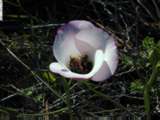| |
 |
The steepness of the
terrain and the sandiness of the soil mean that air flow is active and
drainage is excellent.
The plants grow in
exposed, sunny locations, which are nonetheless cool because of the
good ventilation, and which are sheltered from the strongest winds.
Light frosts in winter,
when the plants are dormant, do occur once every few years, so dormant
bulbs can handle a couple of degrees of frost under dry conditions.
|
|
| |
|
|
|
| |
 |
The chaparral has
considerable variation in conditions on microscales. In this picture,
the big white inflorescences of Yucca
whipplei can be seen on the
primarily south-facing side of this valley between two ridges, together
with an opuntia cactus plant in the left foreground. The right,
northern-facing side, is slightly cooler and wetter, and is also the
type of area likelier to have catalina mariposas in it.
|
|
| |
|
|
|
| |
 |
A small area with
numerous flowers
besides catalina mariposas. The most obvious blue ones are blue-eyed
grass (Sisyrhynchium bellum),
which is actually in the iris family and is not a grass at all. The
yellow flowers in the distance are members of the daisy family. |
|
| |
|
|
|
| |
 |
We've
seen a number of different bees and beetles visiting the flowers of
catalina mariposa lilies. However, especially early in the season, one
species of bee (which I'm not enough of an entomologist to identify)
positively camps at the base of the anthers with its head in the
nectary. Many flowers have multiple bees, each sitting motionless on
its own spot, as in the picture. They are unwilling to be disturbed
even when the flower is tapped. This type of behavior is observed in
some bees and orchids, when the flower is mimicking insect pheromones
or is otherwise providing what amounts to a drug for the insect. The
pheromone is easier for the plant to produce than "real" nectar
containing sugar, so it gets pollinated while the bee wastes its time,
although pleasantly so. Whether this is what is happening in C.
catalinae, I don't know, but the
behavior of the bees is most interesting. |
|
![]() Ecology of the Mariposa Catalina lily
Ecology of the Mariposa Catalina lily